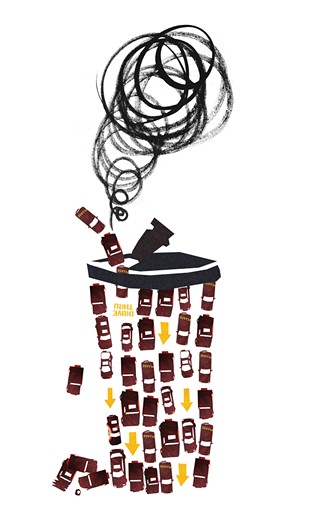St. John's city council started 2009 by becoming the first Canadian municipal power to pass a moratorium on drive-thrus.
The problem was traffic: inconvenient, hazardous lineups right into the highway, especially around the ever-popular, always fresh Canadian wunderkind, Timmy Hortons. When the moratorium was approved, the mayor, deputy mayor and councillors lined up to proclaim the dangers of drive-thrus while praising Tim Hortons' corporate citizenship. You can't blame their doughnuts for being so delicious, they told Canada.
Two weeks later, St. John's became the first Canadian city to rescind its drive-thru moratorium, voting it down unanimously after a meeting with Tim Hortons. "I think council jumped the gun," explains councillor Tom Hann. "We looked closer at the drive-thru permits, and we got a very good plan from Tim Hortons."
Hortons promises myriad measures to curb traffic around its drive-thrus, including double lanes, additional overflow parking space and better layout. Hann adds that council was concerned about sending an "anti-business" message about St. John's.
Environment wasn't part of St. John's rationale for a moratorium, but I was hoping this would be the start of a domino effect. Other Canadian cities have considered restrictions on drive-thrus, including North Vancouver, Edmonton, several mid-sized Ontario cities and Kentville, NS. Toronto is the only city to have acted, banning new drive-thrus in residential and mixed-use neighbourhoods.
St. John's could have been the first bold move away from a hyper-convenient, sedentary culture that is killing us, fast. Only in that culture could a move to get people out of their cars, if even for the time it takes to pour a cup of coffee, be considered "anti-business."
Maybe even HRM, which has never considered explicitly regulating drive-thrus on environmental grounds, would have gotten in the act. According to Denise Schofield, HRM's manager of development engineering, our claim to fame regarding drive-thrus is requiring "a traffic impact study based on the volume of traffic, the length of the drive-thru lane, et cetera. Not every municipality requires that." Like Toronto, our new drive-thrus don't typically assault residential areas, because they aren't zoned for restaurants.
Surely we can do better. Drive-thrus are a symbol of everything wrong with our culture. It's not good enough that someone else grows, ships and makes our coffee for us, oh no, it has to be delivered direct to our SUV window as we idle in a line of foreign-made, big-ticket, steel-and-glass weapons of local destruction we like to call cars.
And drive-thrus don't even work, according to Kentville town councillor Eric Bollard, who unsuccessfully proposed a moratorium in his town last year. "Most of the time you can go into the restaurant and get your order, come out and see the same cars waiting in the drive-thru as were there when you went in," he says.
But drive-thrus are more than just a symbol. Their contribution to melting ice caps is manifest, according to a new study of emissions at six drive-thrus in "the HRM urban core" by Clean Nova Scotia. According to Gina Patterson, the non-profit's DriveWiser coordinator, "when you talk about climate change emissions, you necessarily have more in a drive-thru than parking and going in."
The study categorizes drive-thrus by what they sell and how much traffic they get, and randomly observes restaurants from each category. Tim Hortons commissioned a less representative study of four drive-thrus and one regular-parking, fast-food joint in Ontario. They concluded that air quality was actually worse at the regular-parking only location, but that location happens to be on Bank Street in downtown Ottawa. Yet, "some of the drive-thrus they look at are in low density areas," Patterson says. It's like comparing a city apple to a country orange.
Councillor Hann of St. John's acknowledges the environmental danger, but is satisfied that Tim Hortons is handling that issue. "If you've got 10 cars waiting you have an environmental issue, but taking steps to get cars moving cuts down on the number of idlers." Unfortunately, it does so by building another parking lot and another traffic lane.
Which brings me back to the cultural issue. Worse than sitting in a car in a miniature-Beijing airfield is the fact that, as our old-world carbon economy collapses around us, we continue to build infrastructure around sitting in cars whether they're moving or not.
As Kentville's Eric Bolland, who hopes to pass a revised drive-thru moratorium this year, says, "If gas is at a dollar a litre, you can save 10 cents by turning your car off and going inside to get your coffee, and you get it quicker."
Would you support an HRM ban on drive-thrus? Let Chris Benjamin know at [email protected].












